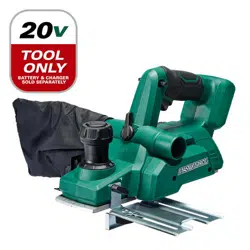Loading ...
Loading ...
Loading ...

Page 6
SAFETY INSTRUCTIONS
SAFETY INSTRUCTIONS FOR
PLANERS
• Wait for the cutter to stop before setting
the tool down. An exposed rotating cutter
may engage the surface leading to possible
loss of control and serious injury.
• Use clamps or another practical way
to secure and support the workpiece to
a stable platform. Holding the workpiece
by your hand or against the body leaves it
unstable and may lead to loss of control.
IMPORTANT SAFETY
INSTRUCTIONS
1. To reduce the risk of electric shock or
damage to the chargers and batteries, use
only with the MASTERFORCE
®
20V battery
packs and chargers listed.
Battery pack Charger
252-8029 (1.5Ah)
252-8031 (2.0Ah)
252-8030 (2.5Ah)
252-8003 (2.5Ah)
252-8034 (4.0Ah)
252-8013 (4.0Ah)
252-8035 (5.0Ah)
252-8005 (5.0Ah)
252-8007 (7.5Ah)
252-8025
252-8026
252-8037
252-8043
2. For best results, your battery and tool
should be stored, charged and used in a
location where the temperature is more
than 41 °F (5 °C) but less than 104 °F (40 °C).
Do not store outside or in vehicles.
DANGER:
People with electronic
devices, such as pacemakers, should
consult their physician(s) before using this
product. Operation of electrical equipment
in close proximity to a heart pacemaker
could cause interference or failure of the
pacemaker.
WARNING:
Some dust created by
power sanding, sawing, grinding, drilling,
and other construction activities contains
chemicals known to the state of California
to cause cancer, birth defects, or other
reproductive harm. Some examples of
these chemicals are:
– Lead from lead-based paints
– Crystalline silica from bricks, cement, and
other masonry products
– Arsenic and chromium from chemically-
treated lumber
Your risk from these exposures varies,
depending on how often you do this type
of work. To reduce your exposure to these
chemicals:
– Work in a well-ventilated area.
– Work with approved safety equipment, such
as dust masks that are specially designed to
filter out microscopic particles.
– Avoid prolonged contact with dust from
power sanding, sawing, grinding, drilling,
and other construction activities. Wear
protective clothing and wash exposed areas
with soap and water. Allowing dust to get into
your mouth or eyes or to lie on the skin may
promote absorption of harmful chemicals.
SAVE THESE INSTRUCTIONS!
Loading ...
Loading ...
Loading ...
